Unidentified Female Student, Former Slave
—Talladega College, circa 1885
You might have heard a story like this one well
but I’m telling this one to you now.
I was five when the soldiers came.
Master worked me twenty years longer.
How could I know? One day he left me alone
and an unwatched pot started to boil. By the time
he came back home I was cleaned of him and singing,
There’s a man going round taking names.
Ready, set, and I was gone, walking. Could I see
beyond his yard? Did I have a thought to read or write
or count past God’s creation? A barefooted
girl!-and you remember, you woman who will take
your pen to write my life. This is what the truth was like:
Master’s clouds followed me to the steps of this school.
Dear reader, when you think on this years after I have died
and I am dust, think on a great and awful morning
when I learned my freedom. Think that the skin on my
back was scared when I dared step out into the world,
when my Master stood trembling and weeping
on his front porch and he cursed me beyond knowing.
by Honorée Fannone Jeffers
from Outlandish Blues
Wesleyan University Press, 2003

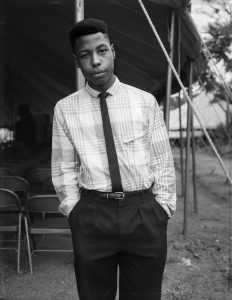 He opened a book of Dawoud Bey’s photographs at random. The images were of people of color, not unlike himself, and what he loved about the images was how the subjects held their own self-validation in their hands, their eyes, without being reduced to an ideology—you know, equating blackness with nobility, that kind of thing. It was such a relief, to see works of art made out of real lives. The pictures named a world he knew, even as he struggled to understand it more. And, even though the pictures hadn’t been shot in Ferguson, Staten Island, or Cincinnati, they shimmered with lives—black male lives. Generally, the language around that familiar and unfamiliar form has little to do with his humanity and more to do with the pressure points—guilt, remorse, and so on—his dead or living self aggravates. And, because he’s less interesting in the context of joy, the continued violence to his body. Under his white shirt, he knew something about that. And this: that the violence inflicted on the black male body didn’t stop there but extended, of course, to his community, which includes mothers and brothers and all the people who never considered him invisible or trivial or tragic or extinguishable to begin with.
He opened a book of Dawoud Bey’s photographs at random. The images were of people of color, not unlike himself, and what he loved about the images was how the subjects held their own self-validation in their hands, their eyes, without being reduced to an ideology—you know, equating blackness with nobility, that kind of thing. It was such a relief, to see works of art made out of real lives. The pictures named a world he knew, even as he struggled to understand it more. And, even though the pictures hadn’t been shot in Ferguson, Staten Island, or Cincinnati, they shimmered with lives—black male lives. Generally, the language around that familiar and unfamiliar form has little to do with his humanity and more to do with the pressure points—guilt, remorse, and so on—his dead or living self aggravates. And, because he’s less interesting in the context of joy, the continued violence to his body. Under his white shirt, he knew something about that. And this: that the violence inflicted on the black male body didn’t stop there but extended, of course, to his community, which includes mothers and brothers and all the people who never considered him invisible or trivial or tragic or extinguishable to begin with.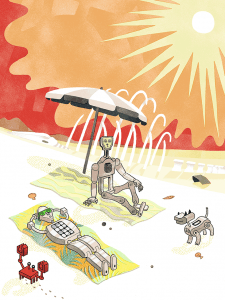 Let’s be optimistic and assume that we manage to avoid a self-inflicted nuclear holocaust, an extinction-sized asteroid, or deadly irradiation from a nearby supernova. That leaves about 6 billion years until the sun turns into a red giant, swelling to the orbit of Earth and melting our planet. Sounds like a lot of time. But don’t get too relaxed. Doomsday is coming a lot sooner than that. The Earth is, in some ways, in a precarious spot in the solar system. There’s a range of orbital distances inside which a planet can have both liquid surface water (which is believed to be necessary for life) and enough atmospheric CO2 to carry on photosynthesis. This range is called the photosynthesis habitable zone. The Earth orbits barely within the sun’s zone. Some scientists estimate that the inner edge lies just 7.5 million kilometers away, which is only 5 percent of the distance between the Earth and the sun.
Let’s be optimistic and assume that we manage to avoid a self-inflicted nuclear holocaust, an extinction-sized asteroid, or deadly irradiation from a nearby supernova. That leaves about 6 billion years until the sun turns into a red giant, swelling to the orbit of Earth and melting our planet. Sounds like a lot of time. But don’t get too relaxed. Doomsday is coming a lot sooner than that. The Earth is, in some ways, in a precarious spot in the solar system. There’s a range of orbital distances inside which a planet can have both liquid surface water (which is believed to be necessary for life) and enough atmospheric CO2 to carry on photosynthesis. This range is called the photosynthesis habitable zone. The Earth orbits barely within the sun’s zone. Some scientists estimate that the inner edge lies just 7.5 million kilometers away, which is only 5 percent of the distance between the Earth and the sun.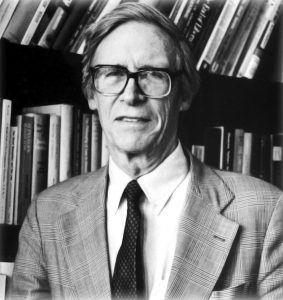 John Rawls was one of the twentieth century’s preeminent liberal philosophers. His major work,
John Rawls was one of the twentieth century’s preeminent liberal philosophers. His major work,  The speed with which campus life has changed for the worse is one of the most important points made by Greg Lukianoff and Jonathan Haidt in this important if disturbing book. Lukianoff is a lawyer and head of the Foundation for Individual Rights in Education (Fire), which works to protect academic freedom. Haidt is a professor of social psychology at NYU’s Stern School of Business and the founder of Heterodox Academy, which promotes intellectual diversity in academic life — the one type of diversity that universities appear not to care about.
The speed with which campus life has changed for the worse is one of the most important points made by Greg Lukianoff and Jonathan Haidt in this important if disturbing book. Lukianoff is a lawyer and head of the Foundation for Individual Rights in Education (Fire), which works to protect academic freedom. Haidt is a professor of social psychology at NYU’s Stern School of Business and the founder of Heterodox Academy, which promotes intellectual diversity in academic life — the one type of diversity that universities appear not to care about. While the recent Heterodox Psychology conference in southern California was filled with highlights, for me, the keynote address by Leda Cosmides and John Tooby, two pioneers in the field of
While the recent Heterodox Psychology conference in southern California was filled with highlights, for me, the keynote address by Leda Cosmides and John Tooby, two pioneers in the field of  Moore was not alone in her writerly affinity with Pratt’s art. Pratt’s Wedding Dress graced the cover of Alice Munro’s 1990 short story collection Friend of My Youth. The late Diana Brebner won the
Moore was not alone in her writerly affinity with Pratt’s art. Pratt’s Wedding Dress graced the cover of Alice Munro’s 1990 short story collection Friend of My Youth. The late Diana Brebner won the  Prior to her death from breast cancer in 1997, Kathy Acker wrote critically on the normative and hegemonic discourses and structures surrounding gender and sexuality, the (feminised) body, and taboos, in particular of sex, pornography and abjected beings. Through the female characters in her novels she explored and situated her own sexed and gendered positionality within systems of power and disciplinary, totalitarian violence. Acker was heralded and criticised for challenging traditional literary conventions, melding the boundaries of fiction, poetry, essay and diary writing or epistolary, of high-brow and low-brow, or as she called it “Schlock”, as well as the distinctions between literature and art. She has often been labelled a writer of the postmodern era, or, at worst, confined as a female literary offspring of William S. Burroughs or David Antin, Charles Olson and other Black Mountain Poets. Yes Acker did plagiarise or “cut-up” existing works, describing it as a crisis of voice as well as a (tactic of guerilla warfare, in the use of fictions, of language). Her Fathers told her to find her own voice, or in other words, to find and then sell her soul; although not as the stuff of essence or transcendent energy, but the individualised Cartesian soul, aka the mind.
Prior to her death from breast cancer in 1997, Kathy Acker wrote critically on the normative and hegemonic discourses and structures surrounding gender and sexuality, the (feminised) body, and taboos, in particular of sex, pornography and abjected beings. Through the female characters in her novels she explored and situated her own sexed and gendered positionality within systems of power and disciplinary, totalitarian violence. Acker was heralded and criticised for challenging traditional literary conventions, melding the boundaries of fiction, poetry, essay and diary writing or epistolary, of high-brow and low-brow, or as she called it “Schlock”, as well as the distinctions between literature and art. She has often been labelled a writer of the postmodern era, or, at worst, confined as a female literary offspring of William S. Burroughs or David Antin, Charles Olson and other Black Mountain Poets. Yes Acker did plagiarise or “cut-up” existing works, describing it as a crisis of voice as well as a (tactic of guerilla warfare, in the use of fictions, of language). Her Fathers told her to find her own voice, or in other words, to find and then sell her soul; although not as the stuff of essence or transcendent energy, but the individualised Cartesian soul, aka the mind. I hadn’t appreciated how important the idea of dignity is to his thought. It structures his critique of the limits placed on human liberty and opportunity by Jim Crow, and his objections to the impoverishment and ghettoization of northern black people. Maybe I also I hadn’t appreciated some of the more pragmatic features of his thought. It’s easy to see King as an idealist, but there’s a strong streak of realism in his work. He’s thinking very hard about what forms of political pressure one must bring to bear in order to realize the most fundamental ideals and principles. There’s a lot of focus on psychology, on diagnosing the mindset of allies and opponents. People often imagine that as a Christian minister he was aligned with moral suasion as the principal means of realizing his political ideals, and neglect the other forms of political maneuvering that are central to his thought.
I hadn’t appreciated how important the idea of dignity is to his thought. It structures his critique of the limits placed on human liberty and opportunity by Jim Crow, and his objections to the impoverishment and ghettoization of northern black people. Maybe I also I hadn’t appreciated some of the more pragmatic features of his thought. It’s easy to see King as an idealist, but there’s a strong streak of realism in his work. He’s thinking very hard about what forms of political pressure one must bring to bear in order to realize the most fundamental ideals and principles. There’s a lot of focus on psychology, on diagnosing the mindset of allies and opponents. People often imagine that as a Christian minister he was aligned with moral suasion as the principal means of realizing his political ideals, and neglect the other forms of political maneuvering that are central to his thought. When you think of sugar, you probably think of the sweet, white, crystalline table sugar that you use to make cookies or sweeten your coffee. But did you know that within our body, simple sugar molecules can be connected together to create powerful structures that have recently been found to be linked to health problems, including cancer, aging and autoimmune diseases. These long sugar chains that cover each of our cells are called glycans, and according to the National Academy of Sciences, creating a map of their location and structure will
When you think of sugar, you probably think of the sweet, white, crystalline table sugar that you use to make cookies or sweeten your coffee. But did you know that within our body, simple sugar molecules can be connected together to create powerful structures that have recently been found to be linked to health problems, including cancer, aging and autoimmune diseases. These long sugar chains that cover each of our cells are called glycans, and according to the National Academy of Sciences, creating a map of their location and structure will 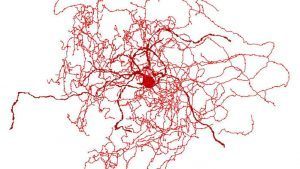 In a mysterious addition to the brain’s family of cells, researchers have discovered a new kind of neuron—a dense, bushy bundle (above) that is present in people but seems to be missing in mice. These “rosehip neurons,” were found in the uppermost layer of the cortex, which is home to many different types of neurons that inhibit the activity of other neurons. Scientists spotted the neurons in slices of human brain tissue as part of a larger effort to inventory human brain cells by combining microscopic study of brain anatomy and the genetic analysis of individual cells. The cells were small and compact, with a dense, bushy shape. At the points along their projections where they transmit signals to other cells—called axonal boutons—they had unusually large, bulbous structures, which inspired their name.
In a mysterious addition to the brain’s family of cells, researchers have discovered a new kind of neuron—a dense, bushy bundle (above) that is present in people but seems to be missing in mice. These “rosehip neurons,” were found in the uppermost layer of the cortex, which is home to many different types of neurons that inhibit the activity of other neurons. Scientists spotted the neurons in slices of human brain tissue as part of a larger effort to inventory human brain cells by combining microscopic study of brain anatomy and the genetic analysis of individual cells. The cells were small and compact, with a dense, bushy shape. At the points along their projections where they transmit signals to other cells—called axonal boutons—they had unusually large, bulbous structures, which inspired their name.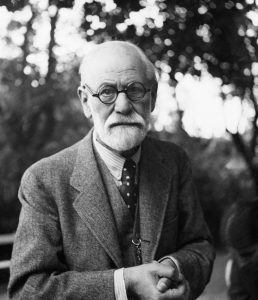 Originally, Freud analyzed only himself, and did so for five years, but he grew exhausted running back and forth between his chair and the couch. He then came up with the idea of analyzing patients, and continued to do so for the rest of his life. At first, Freud sat on the couch and the patient sat at his desk, but he changed places after discovering that his pens were disappearing.
Originally, Freud analyzed only himself, and did so for five years, but he grew exhausted running back and forth between his chair and the couch. He then came up with the idea of analyzing patients, and continued to do so for the rest of his life. At first, Freud sat on the couch and the patient sat at his desk, but he changed places after discovering that his pens were disappearing.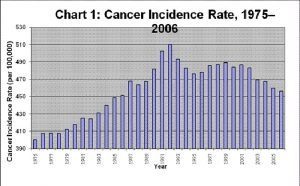 Official statistics say we are winning the War on Cancer. Cancer incidence rates, mortality rates, and five-year-survival rates have generally been moving in the right direction over the past few decades.
Official statistics say we are winning the War on Cancer. Cancer incidence rates, mortality rates, and five-year-survival rates have generally been moving in the right direction over the past few decades.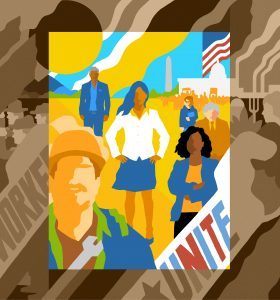 Throughout most of American history, the idea of socialism has been a hopeless, often vaguely defined dream. So distant were its prospects at midcentury that the best definition Irving Howe and Lewis Coser, editors of the socialist periodical Dissent, could come up with in 1954 was this: “Socialism is the name of our desire.”
Throughout most of American history, the idea of socialism has been a hopeless, often vaguely defined dream. So distant were its prospects at midcentury that the best definition Irving Howe and Lewis Coser, editors of the socialist periodical Dissent, could come up with in 1954 was this: “Socialism is the name of our desire.” A mostly overlooked component of
A mostly overlooked component of  While Zanzibar’s political landscape has shifted over the decades, Swahili coastal culture and tradition have remained central to island life. Haji Gora traces his love of language to ngoma, a hypnotic and exuberant drumming that hails from Congo. It’s a Bantu tradition that spread to Zanzibar via a harrowing history of slavery and trade between inland Africa and the Swahili coast, as well as the Arab Peninsula. There are various forms of ngoma, each with its own rhythms and sounds, but Haji Gora was drawn to Ngoma ya Kibati, which features quick, improvised dialogue set to drums while singers and dancers punctuate the rhythms with choral lines.
While Zanzibar’s political landscape has shifted over the decades, Swahili coastal culture and tradition have remained central to island life. Haji Gora traces his love of language to ngoma, a hypnotic and exuberant drumming that hails from Congo. It’s a Bantu tradition that spread to Zanzibar via a harrowing history of slavery and trade between inland Africa and the Swahili coast, as well as the Arab Peninsula. There are various forms of ngoma, each with its own rhythms and sounds, but Haji Gora was drawn to Ngoma ya Kibati, which features quick, improvised dialogue set to drums while singers and dancers punctuate the rhythms with choral lines. Wanderlust is, historically, a German idea. Wandern, meaning to hike or to roam, and lust, of course, meaning to desire, began not as a leisure activity but as a serious existential exercise of going out into nature in order to go into oneself. The Romantics believed this is where happiness and self-contentment could be found. The Germans of the eighteenth century, especially, were enamored with Italy for its natural landscapes, but German men with the time and the means for long hikes tended mostly to traverse their own country’s varied landscapes, from the Rhine Valley to the Harz Mountains to the Elbe Sandstone Mountains, which straddle the Czech Republic nearby.
Wanderlust is, historically, a German idea. Wandern, meaning to hike or to roam, and lust, of course, meaning to desire, began not as a leisure activity but as a serious existential exercise of going out into nature in order to go into oneself. The Romantics believed this is where happiness and self-contentment could be found. The Germans of the eighteenth century, especially, were enamored with Italy for its natural landscapes, but German men with the time and the means for long hikes tended mostly to traverse their own country’s varied landscapes, from the Rhine Valley to the Harz Mountains to the Elbe Sandstone Mountains, which straddle the Czech Republic nearby.